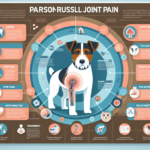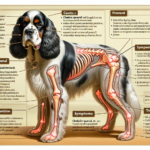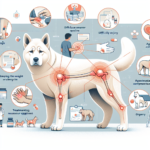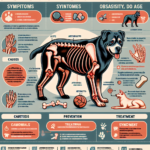Parson Russell Terrier Joint Pain: Causes, Symptoms, Prevention, and Treatment

Introduction
The Parson Russell Terrier, a spirited and intelligent breed, has a rich history dating back to the 19th century. Originally bred by Reverend John Russell in England, these dogs were designed for fox hunting, known for their agility, endurance, and keen hunting instincts. Characterized by their lively personality, strong prey drive, and distinctive white coat with black or tan markings, Parson Russell Terriers are beloved companions and skilled working dogs.
While generally healthy, Parson Russell Terriers are not immune to health issues. Common concerns include eye problems, deafness, and joint-related issues. Joint pain, in particular, can significantly impact their quality of life, making it a crucial area of focus for owners.
Joint health is especially important for Parson Russell Terriers due to their active nature and high energy levels. Ensuring their joints remain healthy is vital for maintaining their mobility, comfort, and overall well-being.
Breed-Specific Joint Pain Risks
Genetic Predisposition
Parson Russell Terriers, like many breeds, can be genetically predisposed to joint-related issues. Conditions such as hip dysplasia, elbow dysplasia, and arthritis are not uncommon. Hip dysplasia, a malformation of the hip joint, can lead to pain and mobility issues. Elbow dysplasia, involving abnormal development of the elbow joint, can also cause significant discomfort. Arthritis, a degenerative joint disease, often develops as the dog ages, leading to chronic pain and stiffness.
Age-Related Risks
As Parson Russell Terriers age, the risk of joint pain increases. Typically, signs of joint issues may start to appear in middle age, around 5-7 years old. However, some dogs may show symptoms earlier or later, depending on their genetic makeup and lifestyle. It’s essential to monitor for early signs of joint pain as the dog ages to manage and mitigate the impact effectively.
Activity Level and Joint Stress
Parson Russell Terriers are known for their high energy levels and love for physical activity. Whether they are participating in agility sports, hunting, or simply enjoying a vigorous play session, their joints are subjected to significant stress. This constant activity can exacerbate existing joint issues or contribute to the development of new ones. Owners must balance their dog’s need for exercise with the potential risk of joint stress.
Common Symptoms of Joint Pain in Parson Russell Terriers
General Symptoms
Owners should be vigilant for common symptoms of joint pain, including:
- Limping: A noticeable limp or favoring one leg over another.
- Stiffness: Difficulty moving, especially after rest or sleep.
- Reluctance to Move: Hesitation to jump, run, or climb stairs.
- Swelling: Visible swelling around the joints.
- Behavioral Changes: Increased irritability or withdrawal from activities they once enjoyed.
Breed-Specific Symptoms
In Parson Russell Terriers, joint pain may manifest in specific ways due to their unique build and activity levels. Owners might notice:
- Decreased Agility: Reduced enthusiasm for agility exercises or difficulty completing courses.
- Hesitation in Hunting Activities: Reluctance to engage in hunting or tracking behaviors.
- Changes in Gait: An altered gait, such as a bunny hop, which can indicate hip dysplasia.
When to Consult a Vet
If any of the above symptoms are observed, it is crucial to consult a veterinarian promptly. Early intervention can prevent further deterioration and improve the dog’s quality of life. Persistent limping, noticeable pain, or significant changes in behavior should not be ignored.
Preventive Measures for Joint Health
Exercise Recommendations
Maintaining an appropriate exercise regimen is vital for Parson Russell Terriers. While they need regular physical activity to stay healthy, it’s essential to avoid overexertion. Recommended exercises include:
- Moderate Walks: Daily walks that provide enough exercise without overloading the joints.
- Controlled Play: Engaging in play sessions that avoid high-impact activities like excessive jumping.
- Swimming: A low-impact exercise that strengthens muscles without stressing the joints.
Dietary Suggestions
A balanced diet is crucial for joint health. Consider incorporating the following nutrients:
- Glucosamine and Chondroitin: Supplements that support cartilage health and joint function.
- Omega-3 Fatty Acids: Found in fish oil, these help reduce inflammation and support joint health.
- Antioxidants: Vitamins C and E can help reduce oxidative stress on joints.
Weight Management
Maintaining a healthy weight is critical to reducing joint stress. Overweight dogs are more prone to joint issues due to the extra load on their joints. Owners should monitor their dog’s weight and adjust their diet and exercise accordingly to keep them within a healthy range.
Early Screening and Monitoring
Regular veterinary check-ups are essential for early detection of joint issues. Specific screening tests, such as X-rays or joint fluid analysis, can help identify problems before they become severe. Monitoring the dog’s movement and behavior can also provide early clues to potential joint pain.
Treatment Options for Joint Pain
Non-Surgical Treatments
Several non-surgical treatments can help manage joint pain in Parson Russell Terriers:
- Medications: Anti-inflammatory drugs and pain relievers prescribed by a vet can alleviate pain and reduce inflammation.
- Physical Therapy: Exercises and therapies designed to strengthen muscles and improve joint function.
- Lifestyle Adjustments: Modifying the dog’s activity level and environment to reduce joint stress.
Surgical Options
In severe cases, surgical intervention may be necessary. Common surgeries include:
- Hip Replacement: Replacing a damaged hip joint with an artificial one.
- Arthroscopy: A minimally invasive procedure to clean out the joint and remove damaged tissue.
- Joint Fusion: Fusing the bones in a joint to reduce pain and improve stability.
Alternative Therapies
Alternative treatments can also provide relief for joint pain:
- Acupuncture: Using needles to stimulate specific points on the body to relieve pain.
- Hydrotherapy: Water-based exercises that reduce joint stress while improving strength and mobility.
- Massage: Therapeutic massage to improve circulation and reduce muscle tension around the joints.
Lifestyle and Management Tips
Daily Care Routine
A consistent daily care routine can help manage joint pain:
- Regular Exercise: Engage in low-impact activities like walking or swimming.
- Balanced Diet: Provide a diet rich in joint-supporting nutrients.
- Medication Management: Administer prescribed medications as directed by the vet.
Modifying the Home Environment
Making the home more comfortable for a dog with joint pain can significantly improve their quality of life:
- Ramps: Install ramps to help the dog navigate stairs or get onto furniture without jumping.
- Orthopedic Beds: Provide supportive bedding to reduce pressure on the joints.
- Non-Slip Flooring: Use rugs or mats to prevent slipping on hard floors.
Long-Term Management
Long-term management strategies are essential for keeping a Parson Russell Terrier active and happy despite joint pain:
- Regular Vet Visits: Schedule regular check-ups to monitor joint health and adjust treatment plans as needed.
- Consistent Routine: Maintain a consistent exercise and medication routine to manage pain effectively.
- Adapt Activities: Modify activities to suit the dog’s capabilities, ensuring they remain engaged and active without overexertion.
FAQs About Parson Russell Terriers and Joint Pain
What are the early signs of joint pain in Parson Russell Terriers?
Early signs include limping, stiffness, reluctance to move, and changes in behavior such as irritability or withdrawal from activities they once enjoyed.
Can joint pain in Parson Russell Terriers be prevented?
While it may not be entirely preventable, joint pain can be managed and mitigated through proper exercise, a balanced diet, weight management, and regular veterinary check-ups.
Are there specific exercises that are better for Parson Russell Terriers with joint pain?
Low-impact exercises like swimming and moderate walks are ideal. Avoid high-impact activities that can stress the joints.
What dietary supplements can help with joint health?
Supplements like glucosamine, chondroitin, and omega-3 fatty acids can support joint health and reduce inflammation.
When should I consider surgery for my dog’s joint pain?
Surgery should be considered when non-surgical treatments are no longer effective, and the dog’s quality of life is significantly impacted by joint pain.
Conclusion
Joint pain in Parson Russell Terriers is a significant concern that requires proactive management. By understanding the breed-specific risks, recognizing early symptoms, and implementing preventive measures, owners can help ensure their dogs lead active, comfortable lives. Regular veterinary consultations and a tailored care routine are essential for maintaining joint health and addressing any issues promptly. With the right approach, Parson Russell Terriers can continue to enjoy their energetic and adventurous lifestyle despite the challenges of joint pain.




